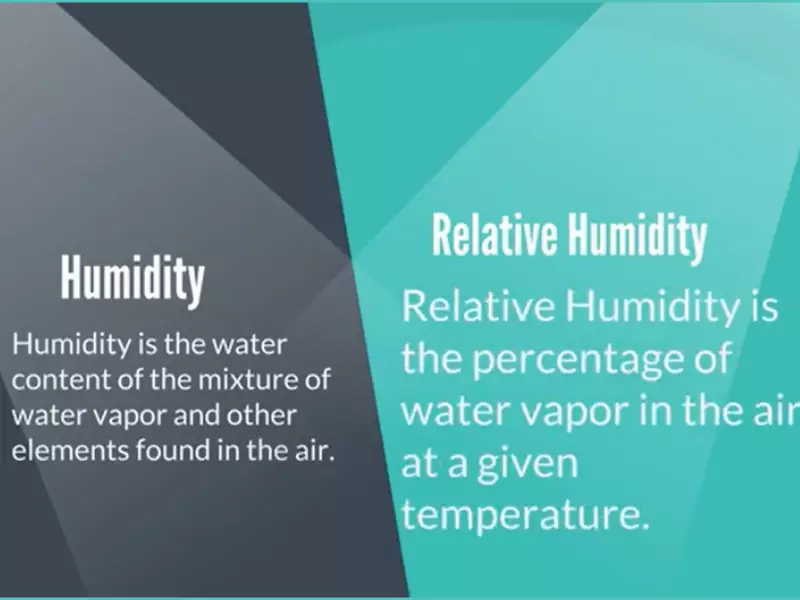Humidity is a common term that pops up in daily weather forecasts, discussions about comfort levels, and even when talking about hair frizz. But beyond these casual mentions lies a deeper understanding of what humidity is and its implications on both our environment and well-being. It represents the amount of water vapor present in the air, a critical factor that influences weather patterns, human health, and comfort.
The difference between humidity and relative humidity is fundamentally about measurement and perception. Humidity, in general, refers to the amount of water vapor in the air. Relative humidity, on the other hand, measures how saturated the air is with water vapor, expressed as a percentage of the maximum amount of water the air can hold at a given temperature.
Knowing the distinction between these two concepts is crucial for various reasons. It affects everything from predicting the weather to managing indoor air quality. Relative humidity, especially, plays a significant role in how comfortable we feel in our environments, as it impacts our body’s ability to cool itself through perspiration.

Humidity Basics
Definition of Humidity
Humidity is the presence of water vapor in the air. It’s a key component of the atmosphere, influencing not only the weather but also our comfort and health. At its core, humidity is about how much moisture is floating around in the air we breathe.
How Humidity is Measured
Measuring humidity is crucial for understanding weather patterns, determining indoor air quality, and even planning daily activities. The primary tools for measuring humidity include:
- Hygrometers: Instruments that measure the moisture content in the air.
- Psychrometers: Devices that use the difference between wet-bulb and dry-bulb temperatures to calculate humidity.
These tools help meteorologists, scientists, and even homeowners to track and manage humidity levels effectively.
Types of Humidity
There are a few different types of humidity to be aware of:
- Absolute humidity: The total amount of water vapor present in a given volume of air, usually measured in grams per cubic meter.
- Specific humidity: Similar to absolute humidity, but it’s the weight of the water vapor divided by the total weight of the air parcel.
- Relative humidity: A more commonly used measure, relative humidity is the ratio of the current absolute humidity to the highest possible absolute humidity at that temperature, expressed as a percentage.
Relative Humidity Explained
Definition of Relative Humidity
Relative humidity (RH) is essentially a way to express how full of water the air is relative to its maximum capacity at a given temperature. It’s a percentage value that tells us how close the air is to being saturated with water vapor. High RH can make the air feel much warmer than the actual temperature because our sweat evaporates more slowly in moist air.
Factors Affecting Relative Humidity
Several factors can influence relative humidity:
- Temperature: Warmer air can hold more water vapor than cooler air.
- Water vapor content: Adding or removing moisture from the air changes the RH.
- Location and time of day: Coastal areas and mornings typically have higher RH levels.
How Relative Humidity is Calculated
The calculation of relative humidity involves comparing the amount of moisture in the air to the maximum amount of moisture the air can hold at a specific temperature. It can be simplified as:
- Measure the current air temperature.
- Determine the current amount of moisture in the air (absolute humidity).
- Calculate the maximum amount of moisture the air can hold at that temperature.
- Divide the current moisture level by the maximum possible level and multiply by 100 to get the RH percentage.
Key Differences
Comparison Between Humidity and Relative Humidity
While both terms relate to the presence of water vapor in the air, humidity generally refers to the absolute amount of water vapor, without taking temperature into account. Relative humidity, however, considers how saturated the air is with water vapor relative to its temperature. This distinction is crucial for understanding weather reports, indoor air quality, and human comfort.
Role of Temperature in Defining Relative Humidity
Temperature plays a critical role in defining RH because it determines the air’s capacity to hold water vapor. As temperature goes up, so does the potential for the air to hold more moisture. This interplay between temperature and humidity is why RH can vary significantly over the course of a day, even if the actual moisture content in the air remains constant.
Importance in Daily Life
Health Impacts
The right balance of humidity and relative humidity is vital for maintaining good health. High RH levels can lead to mold growth and exacerbate allergies, while low RH can dry out the skin and mucous membranes, increasing susceptibility to respiratory infections.
Comfort Levels
Comfort is highly dependent on both temperature and RH. High humidity can make temperatures feel hotter, while low humidity can make the air feel cooler than it actually is. Managing RH levels is key to creating comfortable living and working environments.
Influence on Weather Predictions
Understanding humidity and RH is essential for accurate weather predictions. RH helps meteorologists determine the likelihood of precipitation, fog, or dew, which in turn affects forecasts and weather warnings.

Humidity vs. Relative Humidity in Weather Reports
How Weather Forecasts Use These Terms
Weather forecasts often mention humidity and relative humidity to give viewers a better understanding of the day’s weather conditions. Humidity figures, while less commonly cited directly, underpin much of the forecast’s discussion around moisture, such as the chance of rain or fog. Relative humidity, however, is more frequently mentioned and crucial for interpreting how the day’s weather will feel. High relative humidity levels on a hot day, for example, can make it feel oppressively warm because our sweat evaporates more slowly, reducing our bodies’ ability to cool down.
Interpreting Weather Reports for Planning Activities
Understanding the mention of humidity levels in weather reports can significantly aid in planning daily activities. For instance:
- High relative humidity forecasts are a signal to dress lightly and stay hydrated if you’re planning to be outdoors.
- Low humidity levels might indicate a good day for painting or woodworking, as materials like paint and wood behave differently under various humidity conditions.
Effects on Living Environments
Home
The level of humidity in your home can significantly affect comfort and health. High humidity can encourage mold growth and increase dust mites, while low humidity can cause dry skin and respiratory irritation. Managing home humidity levels is, therefore, crucial for a healthy living environment.
Workplace
Similarly, workplace humidity levels can influence employee comfort, productivity, and health. Offices with controlled humidity see fewer health complaints and better overall employee satisfaction. This balance is often achieved through HVAC systems that regulate temperature and moisture levels in the air.
Outdoor Activities
Planning outdoor activities also requires a consideration of humidity levels. High relative humidity can make physical activities more strenuous and increase the risk of heat-related illnesses. Conversely, low humidity can increase dehydration risks and make cold environments feel even colder.
Managing Humidity Levels
Strategies for Controlling Indoor Humidity
Managing indoor humidity is key to maintaining a comfortable and healthy environment. Some effective strategies include:
- Ventilation: Improving airflow can help manage moisture levels, especially in areas like kitchens and bathrooms where water vapor is frequently generated.
- Dehumidifiers: These are essential in damp environments to reduce moisture levels.
- Humidifiers: In dry climates or during winter, humidifiers can add necessary moisture to the air.
- Plants: Some houseplants can help regulate indoor humidity through transpiration.
Tools and Technology for Measurement and Control
Several tools and technologies can aid in measuring and controlling indoor humidity:
- Hygrometers: These measure the humidity level in your home or workplace and can help you decide when to use a humidifier or dehumidifier.
- Smart HVAC systems: Modern HVAC systems can automatically adjust indoor temperature and humidity levels for optimal comfort.
- Smart home systems: These systems can monitor and adjust the climate in your home, including humidity levels, often controllable via smartphones.
Frequently Asked Questions
What is the simplest way to explain relative humidity?
Relative humidity is the ratio of the current amount of water vapor in the air to the maximum amount it can hold at that temperature, expressed as a percentage. It’s a measure that indicates the likelihood of precipitation, dew, or fog. A higher relative humidity means the air is closer to being saturated with water vapor, which can affect comfort levels and weather conditions.
How does temperature affect relative humidity?
Temperature has a significant impact on relative humidity. As temperature increases, the air can hold more water vapor. Therefore, if the amount of moisture remains constant but the temperature rises, the relative humidity will decrease, and vice versa. This relationship is why relative humidity varies throughout the day, even if the actual amount of moisture in the air stays the same.
Can humidity levels affect health?
Yes, humidity levels can significantly affect health. High humidity can hinder the body’s ability to cool itself, leading to heat exhaustion or heatstroke in extreme cases. On the other hand, low humidity can cause dry skin, irritation of the respiratory tract, and increased susceptibility to colds and other infections. Maintaining an optimal humidity level is crucial for comfort and health.
Why is it important to control indoor humidity levels?
Controlling indoor humidity levels is essential for creating a comfortable and healthy living environment. Too much humidity can promote the growth of mold, dust mites, and other allergens, while too little humidity can lead to dry air that exacerbates respiratory problems and skin irritation. Proper humidity levels also help preserve the integrity of a building’s structure and the condition of its contents.
Conclusion
Understanding the distinction between humidity and relative humidity is more than an academic exercise; it’s a practical necessity for navigating the complexities of weather patterns, maintaining health, and ensuring comfort in living and working environments. This knowledge empowers individuals to make informed decisions about air quality management, clothing choices, and activity planning based on weather forecasts.
In summary, while humidity might seem like a simple concept, its implications are vast and varied. By comprehending the difference between humidity and relative humidity, one can better understand how to adapt to and influence the environments we occupy. Armed with this understanding, we can enhance our well-being and efficiently manage the spaces we live and work in, regardless of the weather outside.
